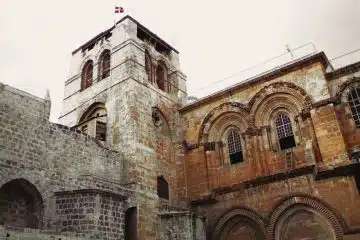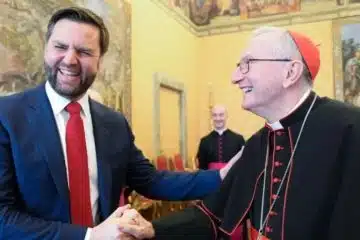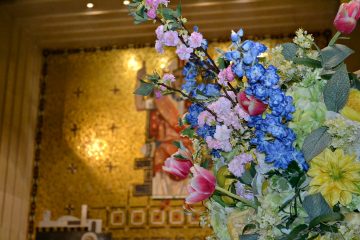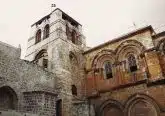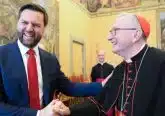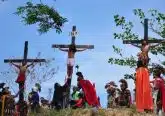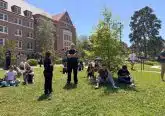Congregation centennial: Supporting Eastern Catholics against all odds

IMAGE: CNS photo/Laura Ieraci
By Cindy Wooden
VATICAN CITY (CNS) — The Vatican is celebrating the 100th anniversary of the establishment of the Congregation for Eastern Churches, an office that supports the Eastern Catholic churches and strives to ensure that the universal Catholic Church treasures its diversity, including in liturgy, spirituality and even canon law.
Coincidentally established five months before the Russian Revolution, the congregation continually has had to face the real persecution and threatened existence of some of the Eastern churches it was founded to fortify.
Until 1989-90, many of the Byzantine Catholic churches — including, notably, the Ukrainian Catholic Church, the largest of all the Eastern churches — were either outlawed or severely repressed by the communist governments of Eastern Europe, said Archbishop Cyril Vasil, a member of the Slovak Catholic Church and secretary of the congregation.
No sooner had the Soviet bloc disintegrated and once-persecuted churches begun to flourish, then the first Gulf War broke out. And then there was the invasion of Iraq. And the turmoil of the Arab Spring across North Africa. Then the war in Syria. And Israeli-Palestinian tensions continue. The Chaldean, Syriac Catholic, Coptic Catholic, Melkite and Maronite churches have paid a high price.
“In all of this, the Eastern churches suffer the most because they find themselves crushed in the struggle between bigger powers, both local and global,” Archbishop Vasil said in mid-August. Even those conflicts that are not taking direct aim at Christians in the Middle East make life extremely difficult for them, and so many decide to seek a more peaceful life for themselves and their families outside the region.
One impact of the “exodus,” he said, is the greater globalization of the Catholic Church. While 100 years ago, when the Congregation for Eastern Churches was established, only a few Eastern churches had eparchies — dioceses — outside their traditional homelands, today they can be found in Australia, North and South America and scattered across Western Europe.
“In Sweden today, a third of the Christians are Chaldeans or Armenians,” he added. “In Belgium and Holland, where Catholicism has suffered a decline, communities are reborn with the arrival of new Christians, which is a reminder of the importance of immigrants bringing their faith with them.”
In countries like Italy, where thousands of Ukrainians and Romanians have come to work, they add ritual diversity to the expressions of Catholicism already found there, he said.
The growing movement of people around the globe means that part of the congregation’s job is to work with the Latin-rite bishops and dioceses, “sensitizing church public opinion” to the existence, heritage, needs and gifts of the Eastern Catholics moving into their communities, the archbishop said. Where an Eastern Catholic hierarchy has not been established, the local Latin-rite bishop has a responsibility “to accept, welcome and give respectful support to the Eastern Catholics” as their communities grow and become more stable.
The idea, Archbishop Vasil said, is to help the local Latin-rite bishop seriously ask himself, “How can I help them free themselves of me and get their own bishop?”
Although it has only 26 employees — counting the prefect, Cardinal Leonardo Sandri, and the receptionist — the Congregation for Eastern Churches works with 23 Eastern Catholic churches and communities, fulfilling the same tasks that for Latin-rite Catholics fall to the congregations for bishops, clergy, religious, divine worship and education. It supports the Pontifical Oriental Institute, which offers advanced degrees in Eastern Christian liturgy, spirituality and canon law. And it also coordinates the work of a funding network known by the Italian acronym ROACO; the U.S.-based Catholic Near East Welfare Association and Pontifical Mission for Palestine are part of that network.
The congregation’s approach in some areas is different than its Latin-rite counterparts because it follows the Eastern Catholic traditions and the Code of Canons of the Eastern Churches. For instance, some of the Eastern churches ordain married men to the priesthood.
And, like the Congregation for Bishops, the Congregation for Eastern Churches helps prepare the nomination of bishops by Pope Francis, but only for dioceses outside the Eastern churches’ traditional homeland. The Eastern Catholic synods of bishops elect new bishops closer to home and submit their names to the pope for his assent.
But the congregation’s primary concern is the survival of the Eastern Catholic churches, which is an issue not only in places where Eastern Catholics are threatened with death or driven from their homelands by war.
Archbishop Vasil said others risk losing their Eastern Catholic identity through assimilation.
Some of the blame, at least before the Second Vatican Council, lies with the Vatican and the Latin-rite hierarchy and religious orders, who, for decades encouraged Eastern Catholics to be more like their Latin-rite brothers and sisters.
Vatican II urged a recovery of the Eastern Catholic traditions, liturgy and spirituality. But, especially for Eastern Catholics living far from their churches’ homelands, uprooting vestiges of the “Latinization” can prove difficult, Archbishop Vasil said.
Using his own Slovak Catholic Church as an example, he said parishes have been asked beginning Sept. 1 to return to the Eastern Catholic tradition of administering baptism, chrismation (confirmation) and the Eucharist together at the same liturgy, even for infants. In Slovakia, as in some parishes in North America, Eastern Catholics adopted the Latin-rite church’s practicing of withholding the Eucharist until a child is about 7 and then celebrating the child’s first Communion.
Especially for Eastern Christians whose ancestors immigrated two or three or four generations ago, the archbishop said, maintaining their specific identity as Chaldean, Ruthenian or Syro-Malankara Catholics is a challenge.
“The greatest danger in the coming years is extinction,” Archbishop Vasil said. “We don’t know what history has in store for us, but we must make sure we have done everything possible to avoid this danger.”
– – –
Follow Wooden on Twitter: @Cindy_Wooden.
– – –
Copyright © 2017 Catholic News Service/U.S. Conference of Catholic Bishops. www.catholicnews.com. All rights reserved. Republishing or redistributing of CNS content, including by framing or similar means without prior permission, is prohibited. You may link to stories on our public site. This copy is for your personal, non-commercial use only. To request permission for republishing or redistributing of CNS content, please contact permissions at [email protected].



